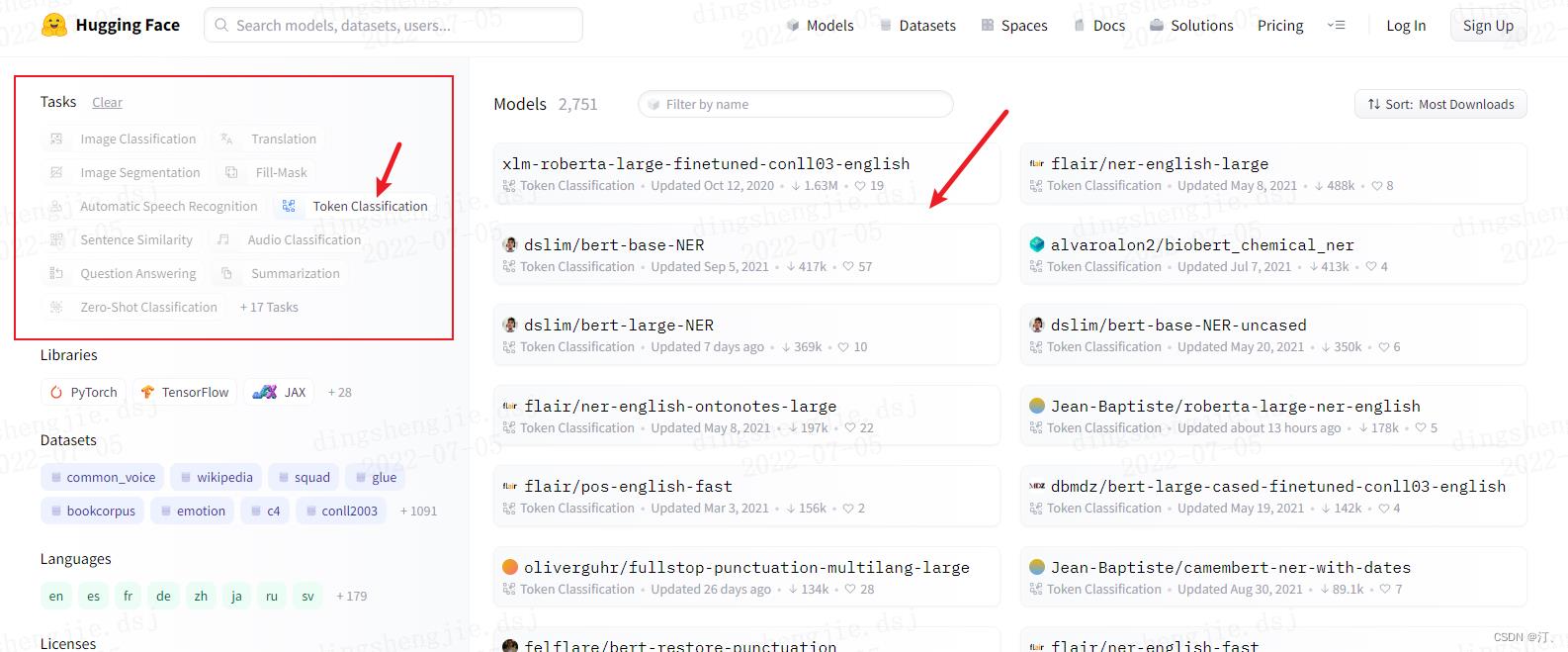基于 hugging face 预训练模型的实体识别智能标注方案:生成doccano要求json格式
Posted 汀、
tags:
篇首语:本文由小常识网(cha138.com)小编为大家整理,主要介绍了基于 hugging face 预训练模型的实体识别智能标注方案:生成doccano要求json格式相关的知识,希望对你有一定的参考价值。
强烈推荐:数据标注平台doccano----简介、安装、使用、踩坑记录_汀、的博客-CSDN博客_doccano
参考:数据标注平台doccano----简介、安装、使用、踩坑记录
1.hugging face

相关教程直接参考别人的:与训练模型
【Huggingface Transformers】保姆级使用教程—上 - 知乎
【Huggingface Transformers】保姆级使用教程02—微调预训练模型 Fine-tuning - 知乎
huggingface transformers的trainer使用指南 - 知乎
2.doccano标注平台格式要求
doccano平台操作参考文章开头链接:
json格式导入数据格式要求: 实体;包含关系样式展示

"text": "Google was founded on September 4, 1998, by Larry Page and Sergey Brin.",
"entities": [
"id": 0,
"start_offset": 0,
"end_offset": 6,
"label": "ORG"
,
"id": 1,
"start_offset": 22,
"end_offset": 39,
"label": "DATE"
,
"id": 2,
"start_offset": 44,
"end_offset": 54,
"label": "PERSON"
,
"id": 3,
"start_offset": 59,
"end_offset": 70,
"label": "PERSON"
],
"relations": [
"from_id": 0,
"to_id": 1,
"type": "foundedAt"
,
"from_id": 0,
"to_id": 2,
"type": "foundedBy"
,
"from_id": 0,
"to_id": 3,
"type": "foundedBy"
]
3. 实体智能标注+格式转换
3.1 长文本(一个txt长篇)
注释部分包含预训练模型识别实体;以及精灵标注助手格式要求
from transformers import pipeline
import os
from tqdm import tqdm
import pandas as pd
from time import time
import json
def return_single_entity(name, start, end):
return [int(start), int(end), name]
# def return_single_entity(name, word, start, end, id, attributes=[]):
# entity =
# entity['type'] = 'T'
# entity['name'] = name
# entity['value'] = word
# entity['start'] = int(start)
# entity['end'] = int(end)
# entity['attributes'] = attributes
# entity['id'] = int(id)
# return entity
# input_dir = 'E:/datasets/myUIE/inputs'
input_dir = 'C:/Users/admin/Desktop//test_input.txt'
output_dir = 'C:/Users/admin/Desktop//outputs'
tagger = pipeline(task='ner', model='xlm-roberta-large-finetuned-conll03-english',
aggregation_strategy='simple')
keywords = 'PER': '人', 'ORG': '机构' # loc 地理位置 misc 其他类型实体
# for filename in tqdm(input_dir):
# # 读取数据并自动打标
# json_list = []
with open(input_dir, 'r', encoding='utf8') as f:
text = f.readlines()
json_list = [0 for i in range(len(text))]
for t in text:
i = t.strip("\\n").strip("'").strip('"')
named_ents = tagger(i) # 预训练模型
# named_ents = tagger(text)
df = pd.DataFrame(named_ents)
""" 标注结果:entity_group score word start end
0 ORG 0.999997 National Science Board 18 40
1 ORG 0.999997 NSB 42 45
2 ORG 0.999997 NSF 71 74"""
# 放在循环里面,那每次开始新的循环就会重新定义一次,上一次定义的内容就丢了
# json_list = [0 for i in range(len(text))]
entity_list=[]
# entity_list2=[]
for index, elem in df.iterrows():
if not elem.entity_group in keywords:
continue
if elem.end - elem.start <= 1:
continue
entity = return_single_entity(
keywords[elem.entity_group], elem.start, elem.end)
entity_list.append(entity)
# entity_list2.append(entity_list)
json_obj = "text": text[index], "label": entity_list
json_list[index] = json.dumps(json_obj)
# entity_list.append(entity)
# data = json.dumps(json_list)
# json_list.append(data)
with open(f'output_dir/data_2.json', 'w', encoding='utf8') as f:
for line in json_list:
f.write(line+"\\n")
# f.write('\\n'.join(data))
# f.write(str(data))
print('done!')
# 转化为精灵标注助手导入格式(但是精灵标注助手的nlp标注模块有编码的问题,部分utf8字符不能正常显示,会影响标注结果)
# id = 1
# entity_list = ['']
# for index, elem in df.iterrows():
# if not elem.entity_group in keywords:
# continue
# entity = return_single_entity(keywords[elem.entity_group], elem.word, elem.start, elem.end, id)
# id += 1
# entity_list.append(entity)
# python_obj = 'path': f'input_dir/filename',
# 'outputs': 'annotation': 'T': entity_list, "E": [""], "R": [""], "A": [""],
# 'time_labeled': int(1000 * time()), 'labeled': True, 'content': text
# data = json.dumps(python_obj)
# with open(f'output_dir/filename.rstrip(".txt").json', 'w', encoding='utf8') as f:
# f.write(data)识别结果:
"text": "The company was founded in 1852 by Jacob Estey\\n", "label": [[35, 46, "\\u4eba"]]
"text": "The company was founded in 1852 by Jacob Estey, who bought out another Brattleboro manufacturing business.", "label": [[35, 46, "\\u4eba"], [71, 82, "\\u673a\\u6784"]]
可以看到label标签是乱码的,不用在意导入到doccano平台后会显示正常

3.2 短文本多个(txt文件)
from transformers import pipeline
import os
from tqdm import tqdm
import pandas as pd
import json
def return_single_entity(name, start, end):
return [int(start), int(end), name]
input_dir = 'C:/Users/admin/Desktop/inputs_test'
output_dir = 'C:/Users/admin/Desktop//outputs'
tagger = pipeline(task='ner', model='xlm-roberta-large-finetuned-conll03-english', aggregation_strategy='simple')
json_list = []
keywords = 'PER': '人', 'ORG': '机构'
for filename in tqdm(os.listdir(input_dir)[:3]):
# 读取数据并自动打标
with open(f'input_dir/filename', 'r', encoding='utf8') as f:
text = f.read()
named_ents = tagger(text)
df = pd.DataFrame(named_ents)
# 转化为doccano的导入格式
entity_list = []
for index, elem in df.iterrows():
if not elem.entity_group in keywords:
continue
if elem.end - elem.start <= 1:
continue
entity = return_single_entity(keywords[elem.entity_group], elem.start, elem.end)
entity_list.append(entity)
file_obj = 'text': text, 'label': entity_list
json_obj = json.dumps(file_obj)
json_list.append(json_obj)
with open(f'output_dir/data3.json', 'w', encoding='utf8') as f:
f.write('\\n'.join(json_list))
print('done!')
3.3 含标注精灵格式要求转换
from transformers import pipeline
import os
from tqdm import tqdm
import pandas as pd
from time import time
import json
def return_single_entity(name, word, start, end, id, attributes=[]):
entity =
entity['type'] = 'T'
entity['name'] = name
entity['value'] = word
entity['start'] = int(start)
entity['end'] = int(end)
entity['attributes'] = attributes
entity['id'] = int(id)
return entity
input_dir = 'E:/datasets/myUIE/inputs'
output_dir = 'E:/datasets/myUIE/outputs'
tagger = pipeline(task='ner', model='xlm-roberta-large-finetuned-conll03-english', aggregation_strategy='simple')
keywords = 'PER': '人', 'ORG': '机构'
for filename in tqdm(os.listdir(input_dir)):
# 读取数据并自动打标
with open(f'input_dir/filename', 'r', encoding='utf8') as f:
text = f.read()
named_ents = tagger(text)
df = pd.DataFrame(named_ents)
# 转化为精灵标注助手导入格式(但是精灵标注助手的nlp标注模块有编码的问题,部分utf8字符不能正常显示,会影响标注结果)
id = 1
entity_list = ['']
for index, elem in df.iterrows():
if not elem.entity_group in keywords:
continue
entity = return_single_entity(keywords[elem.entity_group], elem.word, elem.start, elem.end, id)
id += 1
entity_list.append(entity)
python_obj = 'path': f'input_dir/filename',
'outputs': 'annotation': 'T': entity_list, "E": [""], "R": [""], "A": [""],
'time_labeled': int(1000 * time()), 'labeled': True, 'content': text
data = json.dumps(python_obj)
with open(f'output_dir/filename.rstrip(".txt").json', 'w', encoding='utf8') as f:
f.write(data)
print('done!')
以上是关于基于 hugging face 预训练模型的实体识别智能标注方案:生成doccano要求json格式的主要内容,如果未能解决你的问题,请参考以下文章